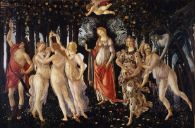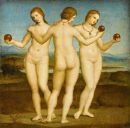The Three Graces and Pleasing Bodies
One panel in particular that stands out is that of the three dancing women. The scene might even strike you as familiar. This is not strange – the image of three women dancing in white, flowing garments has been depicted many times in the Western world. Why? Because that is how the Three Graces, or Charites, the Greek Goddesses of charm, beauty, nature, human creativity, goodwill and fertility are usually depicted. Their image stems from antiquity, but they became a beloved theme in art again from the Renaissance period onwards. Famous depictions include those made by Botticelli, Raphael, Rubens and Canova. Compare the detail of the wallpaper to their depictions, and you will see the resemblances.
It is very interesting that such a clear reference to Antiquity is present in the wallpaper – the three women are simultaneously familiar as well as foreign. Their dress and environment are supposed to be tribal and signify foreignness, yet their appearance and body language, with their fair skin and elegant movements, are reminiscent of more familiar scenes. This was probably not how these Indigenous women actually danced – traditional Hawaiian dances, for example, involve a lot of movements focused on the earth, with bent knees and movements that resemble stomping or powerful waves. Yet it is precisely this inaccurate but familiar connotation of grace that pushes these women into the exotic image. Think about the noble savage again; a pleasing body living in harmony with nature in a paradise. Their depiction is very similar to La Primavera (Spring) by Botticelli, where the Three Graces stand in a garden in full bloom that resembles a paradise, a scene often associated with the ideal of Neoplatonic love. Thereby, a link from the three Indigenous women to a lost paradise of love is made.
Although this image of the noble savage was introduced over 200 years ago, it is ever present in today’s society. In political debates, but also in daily life, Indigenous people are still seen as groups with less agency, and Indigenous women are heavily sexualized and usually seen as submissive and pleasing. It is an ongoing struggle to break away from this narrative that has been perpetuated for so many years. Attempts to break it have been faced with negative reactions ranging from disapproval to (colonial) violence. However, there have been some gradual changes to the reception of these attempts. The next step will look at how the narrative of Les Sauvages de la Mer Pacifique has been reshaped by Lisa Reihana.




